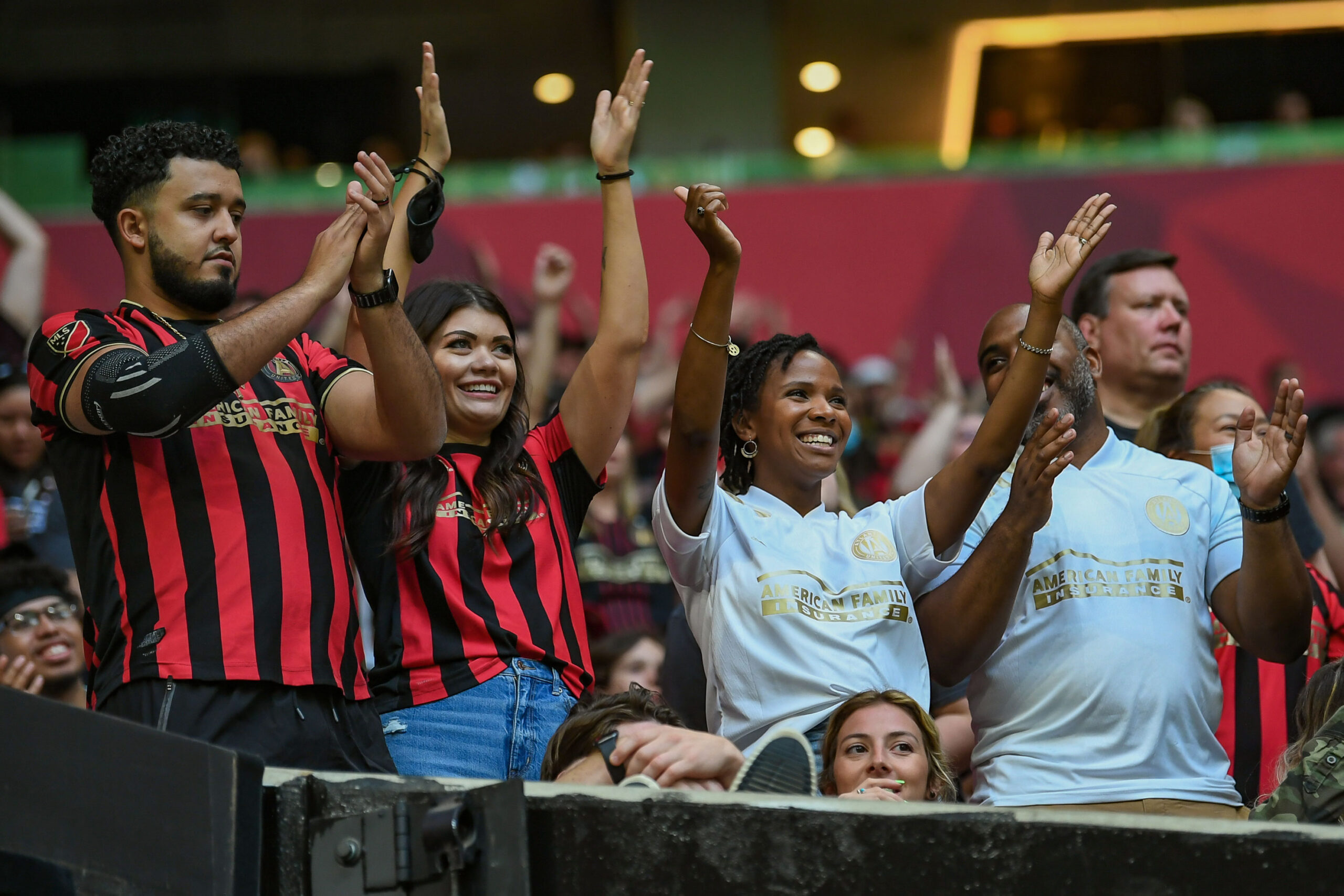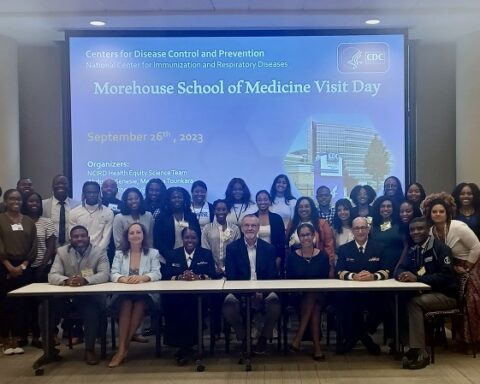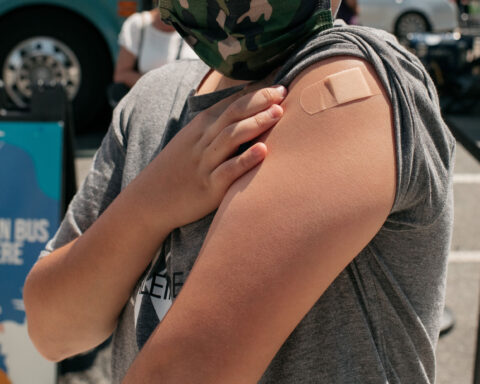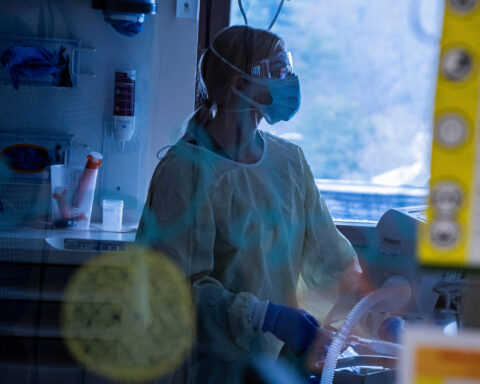Vaccinated Americans spent the most normal weekend for more than a year exploring restored freedoms to gather without masks but also dilemmas over personal and collective responsibility sparked by new government health guidance.
After many months of being told to mask up and keep their distance, millions of citizens are now grappling with when, whether and where to ditch or wear face coverings as a more hopeful stage dawns in a still dangerous crisis.
While there is a sense of national liberation at last, there’s also a risk the new advice will cause mask and vaccine skeptics to ignore precautions entirely, putting themselves and those yet to be vaccinated at increased risk. The chance to drop masks is also forcing many people to confront peer pressure and questions of social etiquette as they consider how to behave. The question is particularly tough for parents of children who are too young to be inoculated but could be more exposed to the virus in places like supermarkets as masks disappear. The same is true for people who may have compromised immune systems because of personal health issues.
The new US Centers for Disease Control and Prevention guidelines suddenly released on Thursday also caused on-the-fly decisions by states, local and city authorities and employers to either remove or keep mask requirements.
There is now a patchwork of inconsistency in rules and accepted practice for shops, restaurants and sports events — sometimes within the same region — as authorities consider the new procedures on masking. It will probably take days or weeks for a more uniform pattern to emerge. The teething issues and confusion also underscore not just the enormity of the endeavor in emerging from the first major pandemic in 100 years, but the psychological toll of a crisis that has forced millions of people to cut themselves off from their communities, regular work and recreational habits.
But from New York to New Orleans and from Pennsylvania to California, many Americans, tentatively in many cases, began to show all of their faces in public for the first time in many months. This weekend marked the most significant transition closer to normal life yet after mournful months of severed social contact and the deaths of nearly 600,000 citizens from Covid-19.
Mask wearing has long been one of the most politicized areas of the pandemic, not least because former President Donald Trumpsought to exploit anger over a perceived threat to personal freedoms for political gain.
Now, in just a few days, as new cases of the virus and deaths fall to levels not seen since last summer, the debate has taken a head spinning shift from being all about putting masks on, to the issues inherent in taking them off.
CDC Chief : ‘This was a first step’
Senior officials on Sunday rigorously defended the new CDC guidance as rooted in solid science, though admitted that the abrupt reversal of previous advice had caused some consternation.
“This was a first step. It was foundational guidance,” CDC Director Dr. Rochelle Walensky said on CNN’s “State of the Union” in reference to guidance that vaccinated Americans no longer need to wear masks or social distances in most circumstances they will encounter in every day life.
“Everybody’s really thinking about what this means now, at this moment, 16 months later, as we really think about opening up. And we needed to sort of set this foundation, based on the science, to make sure people understood as they make their recommendations moving forward.”
Walensky also called on people to make responsible decisions about their own health and the welfare of others while considering whether to change their behavior based on the new guidelines.
“What we’re really asking in those settings, is to say, in terms of the honor system, people have to be honest with themselves,” Walensky said. “You’re protected if you’re vaccinated, you’re not if you’re not vaccinated.”
The government’s top infectious diseases specialist Dr. Anthony Fauci said that the guidelines were the result of new science that shows vaccines offer high levels of protection, are effective against variants and mean it is highly unlikely that vaccinated people who contract Covid-19 will pass it on to others.
Fauci admitted on CBS’s “Face the Nation” that “there may be some merit” to complaints that the CDC guidance, swiftly embraced by President Joe Biden as a milestone in the pandemic, had left the nation unprepared and confused about how to behave. But he said authorities will bring out more specific guidance shortly — covering work places, for instance.
“I would imagine, within a period of just a couple of weeks, you’re going to start to see significant clarification of some of the actually understandable and reasonable questions that people are asking.”
‘You can’t trust anyone’
While official Washington is still mulling the policy implications of the new guidance released on Thursday, many people had a first chance to test what it meant for their lives as people slowly began to reconnect, according to CNN reporters and editors across the country.
Shoppers are finding that in some stores they can drop the mask but must wear it in others. Walmart, Trader Joe’s and Costco say that in line with CDC guidance, vaccinated shoppers don’t need to wear masks unless noted otherwise by city officials. CVS and Macy’s have said they are reviewing practices in their stores following the new CDC guidance. Home Depot wants its customers and staff to keep masks on even if they are vaccinated. But Starbucks is relaxing a requirement for facemasks for fully protected customers indoors starting Monday except in locations where they are required by law.
Some vaccinated New Yorkers were enjoying the novelty of sharing car rides with friends for the first time in months with no masks on. Meanwhile, one woman shouted at a passer-by in Brooklyn to put on a mask because “you can’t trust anyone.”
At a minor pro hockey game in Hershey, Pennsylvania, on Saturday some fans in a socially distanced and reduced crowd enjoyed their new freedom to cheer on their hometown Bears with uncovered faces. But perhaps reflecting uncertainty about how to act following the new guidance or in a possible sign of people yet to be fully vaccinated — many others kept their masks on.
The party is gearing up in New Orleans, however. In nightclubs and bars it was mostly only staff who were wearing masks, and adherence to social distancing and face coverings was noticeably relaxed from only a week ago, a CNN staffer in the Big Easy said.
In Washington, DC, a city where there has been widespread observance of mask wearing, joggers and Sunday afternoon strollers around the marble monuments often hedged their bets: with faces uncovered but with masks in hand.
In Orange County, California, in an area that draws people from both liberal and conservative areas, many people were still masked on Sunday, partly because many shops and restaurants still bore signs requiring face coverings.
It was noticeable that families were often masked up together, highlighting the gulf between parents with adolescents who may finally experience liberation and those with younger offspring whose pandemic is far from over.
“Before, everybody else around us was masked and so that helps to protect my one-year-old,” Dr. Leana Wen, a former Baltimore Health Commissioner, said on CNN’s “New Day” this weekend, addressing the question of whether to take young kids into grocery stores or pharmacies. “But now if we go and most of the people are unmasked, I have no way to know if they are unvaccinated and unmasked and therefore a potential danger to my children.”
Maryland Gov. Larry Hogan, a Republican, reacted to the new CDC decision by lifting a state-wide mandate for citizens in most settings. But individual jurisdictions, cities and businesses have leeway to require face coverings.
“The governors, the states have to actually operationalize it. It is hard,” Hogan told Dana Bash on “State of the Union,” referring to the sudden CDC shift.
“There is no way to differentiate between vaccinated and unvaccinated people from a legal requirement basis. So we are still advising people that are not yet vaccinated that it will help keep them safe. The people that are vaccinated, they are completely safe and ready to go about, you know getting their lives back to normal.”
Even with nearly two million Americans still getting Covid-19 shots every day on average, that divide is likely to define American life for the foreseeable future.





